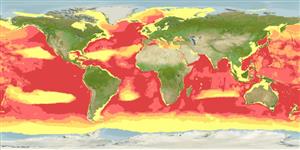Common names from other countries
Classification / Names / Names
Common names | Synonyms | Catalog of Fishes (gen., sp.) | ITIS | CoL | WoRMS
Environment: milieu / climate zone / depth range / distribution range
Ecology
Pelagic; oceanodromous (Ref. 75906); depth range 0 - 3200 m (Ref. 1005), usually 500 - 500 m (Ref. 75906). Tropical; 90°N - 90°S, 180°W - 180°E
Circumglobal.
Length at first maturity / Size / Weight / Age
Maturity: Lm ?, range 830 - 920 cm Max length : 2,400 cm TL male/unsexed; (Ref. 99323); 1200 cm TL (female); max. published weight: 57.0 t (Ref. 1394)
Largest sperm whale (Ref. 1394). Sperm whaling has a long history. The most intense periods were the Yankee whaling era of the 1800s and the factory ship whaling of the 20th century. Recent findings of studies on social behavior and breeding undermine assumptions in the models on which exploitation and management have long been based. Certain populations have been depleted, but the sperm whale remains the most abundant of all the great whales (Great whales generally include the sperm whale and all baleen whales, except the pygmy right whale) (Ref. 1394). Maximum size of female species based from Ref. 1394.
Life cycle and mating behavior
Maturity | Reproduction | Spawning | Eggs | Fecundity | Larvae
Mature females live in socially cohesive groups of 10-30 individuals which include immature males and females and within is a communal suckling and caring of the young. Also, males leave the group at the age of 6 (Ref. 97765).
Jefferson, T.A., S. Leatherwood and M.A. Webber. 1993. (Ref. 1394)
IUCN Red List Status (Ref. 130435: Version 2024-1)
CITES status (Ref. 108899)
Human uses
Fisheries: commercial
FAO - Fisheries: landings, species profile | FishSource | Sea Around Us
Tools
Internet sources
Estimates based on models
Preferred temperature
(Ref.
115969): 0.3 - 3.8, mean 1.7 (based on 39945 cells).
Resilience
Low, minimum population doubling time 4.5 - 14 years (K=0.05-0.16; tm=10).
Vulnerability
Very high vulnerability (83 of 100).
Price category
Unknown.
